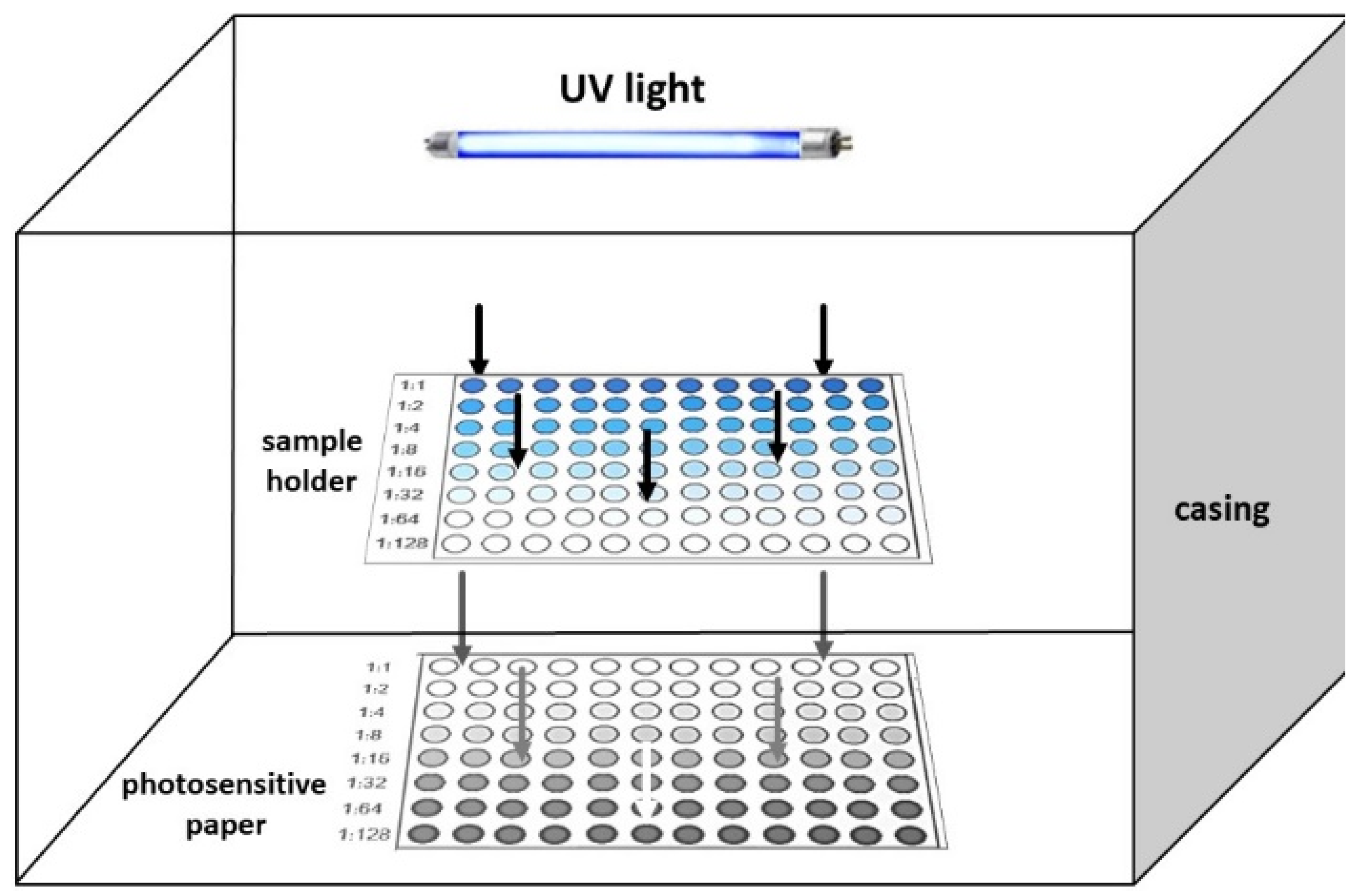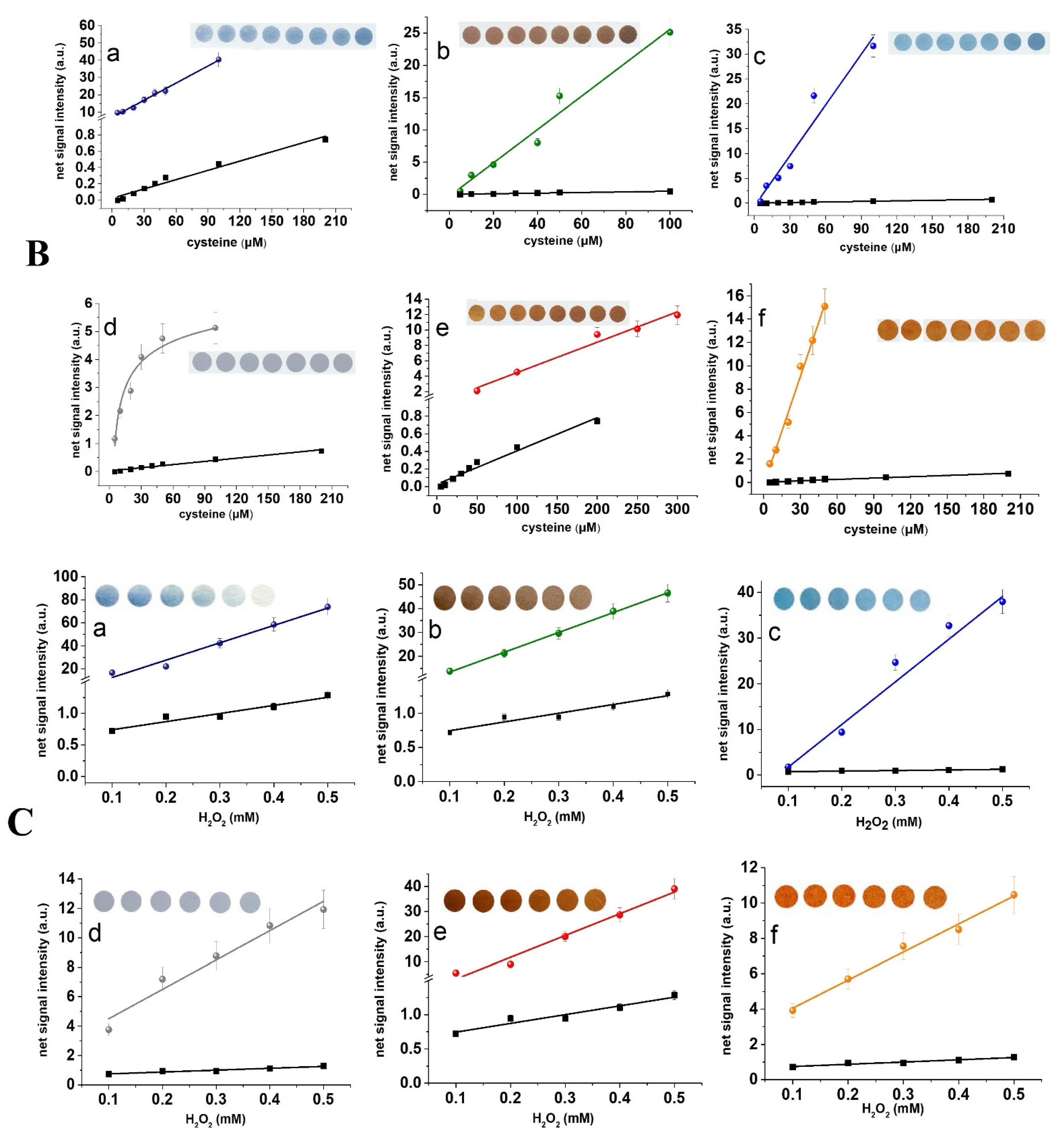Evaluation of Photosensitive Paper Coatings as Detectors for Instrumentation-Free UV Photometric Analysis Based on Photography-Based Photometry
Abstract
:1. Introduction
2. Materials and Methods
2.1. Chemicals and Materials
2.2. Equipment and Instrumentation
2.3. Principles and Calibration of the Assays
2.4. Analysis of Real Samples
3. Results
3.1. UV Sensitivity of Photosensitive Paper Coatings
3.2. Configuration of Photographic-Based Photometry and Optimization of the Assays
3.3. Comparison of Photography-Based Photometry and Photometry
3.4. Application in Pharmaceutical and Biochemical Analysis
4. Conclusions
Supplementary Materials
Author Contributions
Funding
Conflicts of Interest
References
- Christodouleas, D.C.; Kaur, B.; Chorti, P. From Point-of-Care Testing to eHealth Diagnostic Devices (eDiagnostics). ACS Cent. Sci. 2018, 4, 1600–1616. [Google Scholar] [CrossRef] [PubMed]
- Grudpan, K.; Kolev, S.D.; Lapanantnopakhun, S.; McKelvie, I.D.; Wongwilai, W. Applications of everyday IT and communications devices in modern analytical chemistry: A review. Talanta 2015, 136, 84–94. [Google Scholar] [CrossRef] [PubMed]
- Fan, Y.; Li, J.; Guo, Y.; Xie, L.; Zhang, G. Digital image colorimetry on smartphone for chemical analysis: A review. Measurement 2021, 171, 108829. [Google Scholar] [CrossRef]
- Rezazadeh, M.; Seidi, S.; Lid, M.; Pedersen-Bjergaard, S.; Yamini, Y. The modern role of smartphones in analytical chemistry. TrAC Trends Anal. Chem. 2019, 118, 548–555. [Google Scholar] [CrossRef]
- Sun, A.; Wambach, T.; Venkatesh, A.G.; Hall, D.A. A low-cost smartphone-based electrochemical biosensor for point-of-care diagnostics. In Proceedings of the 2014 IEEE Biomedical Circuits and Systems Conference (BioCAS), Lausanne, Switzerland, 22–24 October 2014; IEEE: Piscataway, NJ, USA, 2014; pp. 312–315. [Google Scholar]
- Hernández-Neuta, I.; Neumann, F.; Brightmeyer, J.; Ba Tis, T.; Madaboosi, N.; Wei, Q.; Ozcan, A.; Nilsson, M. Smartphone-based clinical diagnostics: Towards democratization of evidence-based health care. J. Intern. Med. 2019, 285, 19–39. [Google Scholar] [CrossRef] [PubMed] [Green Version]
- Christodouleas, D.C.; Nemiroski, A.; Kumar, A.A.; Whitesides, G.M. Broadly Available Imaging Devices Enable High-Quality Low-Cost Photometry. Anal. Chem. 2015, 87, 9170–9178. [Google Scholar] [CrossRef] [PubMed]
- Calabria, D.; Mirasoli, M.; Guardigli, M.; Simoni, P.; Zangheri, M.; Severi, P.; Caliceti, C.; Roda, A. Paper-based smartphone chemosensor for reflectometric on-site total polyphenols quantification in olive oil. Sens. Actuators B Chem. 2020, 305, 127522. [Google Scholar] [CrossRef]
- Kappi, F.A.; Tsogas, G.Z.; Routsi, A.-M.; Christodouleas, D.C.; Giokas, D.L. Paper-based devices for biothiols sensing using the photochemical reduction of silver halides. Anal. Chim. Acta 2018, 1036, 89–96. [Google Scholar] [CrossRef] [PubMed]
- Tzoka, S.; Tarara, M.; Giokas, D.L. Photography-based photometry: High throughput UV photometric analysis without scientific equipment based on contact printing photography and common imaging devices. Sens. Actuators B Chem. 2021, 328, 129018. [Google Scholar] [CrossRef]
- Akrivi, E.; Kappi, F.; Gouma, V.; Vlessidis, A.G.; Giokas, D.L.; Kourkoumelis, N. Biothiol modulated growth and aggregation of gold nanoparticles and their determination in biological fluids using digital photometry. Spectrochim. Acta Part A Mol. Biomol. Spectrosc. 2021, 249, 119337. [Google Scholar] [CrossRef] [PubMed]
- Akrivi, E.A.; Vlessidis, A.G.; Giokas, D.L.; Kourkoumelis, N. Gold-Modified Micellar Composites as Colorimetric Probes for the Determination of Low Molecular Weight Thiols in Biological Fluids Using Consumer Electronic Devices. Appl. Sci. 2021, 11, 2705. [Google Scholar] [CrossRef]
- Liu, L.; Qiu, C.L.; Chen, Q.; Zhang, S.M. Corrosion behavior of Zr-based bulk metallic glasses in different artificial body fluids. J. Alloy. Compd. 2006, 425, 268–273. [Google Scholar] [CrossRef]
- Moser, M.; Schneider, R.; Behnke, T.; Schneider, T.; Falkenhagen, J.; Resch-Genger, U. Ellman’s and Aldrithiol Assay as Versatile and Complementary Tools for the Quantification of Thiol Groups and Ligands on Nanomaterials. Anal. Chem. 2016, 88, 8624–8631. [Google Scholar] [CrossRef] [PubMed]
- Choleva, T.G.; Gatselou, V.A.; Tsogas, G.Z.; Giokas, D.L. Intrinsic peroxidase-like activity of rhodium nanoparticles, and their application to the colorimetric determination of hydrogen peroxide and glucose. Microchim. Acta 2018, 185, 22. [Google Scholar] [CrossRef] [PubMed]
- El-Saadani, M.; Esterbauer, H.; El-Sayed, M.; Goher, M.; Nassar, A.Y.; Jürgens, G. A spectrophotometric assay for lipid peroxides in serum lipoproteins using a commercially available reagent. J. Lipid Res. 1989, 30, 627–630. [Google Scholar] [CrossRef]
- Blacklow, L. New Dimensions in Photo Processes; Routledge: London, UK, 2018; ISBN 9781315208015. [Google Scholar]
- Bjelkhagen, H.I. Silver-Halide Recording Materials. In Springer Series in Optical Sciences; Springer: Berlin/Heidelberg, Germany, 1995; Volume 66, ISBN 978-3-540-58619-7. [Google Scholar]
- Lawrence, G.D.; Fishelson, S. UV Catalysis, Cyanotype Photography, and Sunscreens. J. Chem. Educ. 1999, 76, 1199. [Google Scholar] [CrossRef]
- Allen, E.; Triantaphillidou, S. The Manual of Photography and Digital Imaging; Allen, E., Triantaphillidou, S., Eds.; Routledge: London, UK, 2012; ISBN 9780080926803. [Google Scholar]



| Assay | Exposure Time (min) | |||||
|---|---|---|---|---|---|---|
| Cyanotype Green | Salted Paper | Cyanotype Blue | Silver Halides | Van Dyke Brown | Gum Dichromate | |
| Paracetamol (254 nm) | 15 | 1 | 6 | 1 | 6 | 20 |
| Ellman-Thiols (312 nm) | 8 | 3 | 2 | 4 | 15 | 13 |
| H2O2-KI (365 nm) | 4 | 2 | 4 | 2 | 10 | 15 |
| Assay | Detection | Calibration Function | Working Range | R2 | LOD a | RSD (%, n = 5) b |
|---|---|---|---|---|---|---|
| Paracetamol (254 nm) | Photometry | y = 0.03x − 0.0026 | 5–50 | 0.999 | 0.6 | 0.7–2.1 |
| Cyanotype green | y = 4.1x + 4.0 | 0.5–30 | 0.98 | 0.16 | 8.3–11.7 | |
| Salted paper | y = 15.6lnx − 4.5 | 1–100 | 0.96 | 0.30 | 8.0–8.3 | |
| Cyanotype blue | y = 9.4lnx − 2.7 | 1–80 | 0.96 | 0.30 | 3.2–6.5 | |
| Silver halide | y = 4lnx + 1.8 | 0.5–100 | 0.98 | 0.15 | 1.2–6.7 | |
| Van dyke brown | y = 6.7lnx − 2.7 | 2.5–50 | 0.94 | 0.8 | 7.1–9.4 | |
| Gum dichromate | y = 3.7lnx + 12.8 | 0.5–20 | 0.98 | 0.1 | 7.6–10.7 | |
| Ellman’s-Thiol (312 nm) | Photometry | y = 0.0062x − 0.004 | 5–200 | 0.97 | 1.6 | 4.0–4.4 |
| Cyanotype green | y = 0.33x + 7.0 | 5–100 | 0.993 | 1.5 | 7.2–8.5 | |
| Salted paper | y = 0.26x − 0.31 | 5–100 | 0.97 | 1.5 | 2.1–4.8 | |
| Cyanotype blue | y = 0.17x + 0.56 | 10–200 | 0.96 | 3.5 | 8.6–9.8 | |
| Silver halide | y = 1.4lnx − 1.06 | 5–100 | 0.97 | 1.6 | 2.3–5.6 | |
| Van dyke brown | y = 0.039x + 0.53 | 50–200 | 0.98 | 12.5 | 6.4–8.2 | |
| Gum dichromate | y = 0.3x − 0.21 | 5–50 | 0.99 | 1.7 | 7.0–9.0 | |
| H2O2-KI (365 nm) | Photometry | y = 1.3x + 0.61 | 0.1–0.5 | 0.97 | 0.03 | 1.5–2.1 |
| Cyanotype green | y = 150.8x − 2.6 | 0.1–0.5 | 0.98 | 0.03 | 6.4–8.1 | |
| Salted paper | y = 83.1x + 5.1 | 0.1–0.5 | 0.998 | 0.01 | 5.6–6.1 | |
| Cyanotype blue | y = 95.8x − 7.4 | 0.1–0.5 | 0.97 | 0.03 | 5.2–7.7 | |
| Silver halide | y = 19.9x + 2.5 | 0.1–0.5 | 0.96 | 0.03 | 3.2–4.9 | |
| Van dyke brown | y = 86.7x − 5.6 | 0.1–0.5 | 0.98 | 0.03 | 8.5–11.0 | |
| Gum dichromate | y = 15.8x + 2.6 | 0.1–0.5 | 0.991 | 0.02 | 9.3–10.3 |
| Photometry | Cyanotype Green | Salted Paper | Cyanotype Blue | Silver Halide Emuslions | Van Dyke Brown | Gum Dichromate | |
|---|---|---|---|---|---|---|---|
| Paracetamol(mg L−1) | 495 ± 17 | 488 ± 36 | 492 ± 20 | 479 ± 30 | 511 ± 15 | 468 ± 44 | 529 ± 43 |
| Relative error (%) a | −1.41 | −0.61 | −3.84 | 4.04 | −5.45 | 6.87 | |
| texperimental b | 0.43 | 0.34 | 1.42 | 2.98 | 1.37 | 1.77 | |
| Fexperimental c | 4.48 | 1.38 | 3.11 | 1.28 | 6.70 | 6.40 | |
| Cysteine (μM) | 102 ± 4 | 98 ± 11 | 100 ± 9 | 108 ± 9 | 93 ± 10 | 87 ± 12 | 118 ± 14 |
| Relative error (%) a | −3.9 | −2.0 | 5.9 | −8.8 | −14.7 | 15.7 | |
| texperimental b | −1.1 | −0.5 | 1.5 | −2.0 | −2.8 | 2.6 | |
| Fexperimental c | 4.5 | 5.1 | 5.1 | 6.3 | 9.0 | 12.3 | |
| Glucose (mM) | 0.25 ± 0.03 | 0.22 ± 0.03 | 0.26 ± 0.06 | 0.21 ± 0.07 | 0.19 ± 0.05 | 0.17 ± 0.09 | 0.31 ± 0.06 |
| Relative error (%) a | −12.0 | 4.0 | −16.0 | −24.0 | −32.0 | 24.0 | |
| texperimental b | 2.24 | 0.37 | 1.28 | 2.68 | 1.99 | 2.24 | |
| Fexperimental c | 1.0 | 4.0 | 5.4 | 2.8 | 9.0 | 4.0 |
Publisher’s Note: MDPI stays neutral with regard to jurisdictional claims in published maps and institutional affiliations. |
© 2021 by the authors. Licensee MDPI, Basel, Switzerland. This article is an open access article distributed under the terms and conditions of the Creative Commons Attribution (CC BY) license (https://creativecommons.org/licenses/by/4.0/).
Share and Cite
Choleva, T.G.; Sfakianaki, A.; Vlessidis, A.G.; Giokas, D.L. Evaluation of Photosensitive Paper Coatings as Detectors for Instrumentation-Free UV Photometric Analysis Based on Photography-Based Photometry. Chemosensors 2021, 9, 233. https://doi.org/10.3390/chemosensors9080233
Choleva TG, Sfakianaki A, Vlessidis AG, Giokas DL. Evaluation of Photosensitive Paper Coatings as Detectors for Instrumentation-Free UV Photometric Analysis Based on Photography-Based Photometry. Chemosensors. 2021; 9(8):233. https://doi.org/10.3390/chemosensors9080233
Chicago/Turabian StyleCholeva, Tatiana G., Afroditi Sfakianaki, Athanasios G. Vlessidis, and Dimosthenis L. Giokas. 2021. "Evaluation of Photosensitive Paper Coatings as Detectors for Instrumentation-Free UV Photometric Analysis Based on Photography-Based Photometry" Chemosensors 9, no. 8: 233. https://doi.org/10.3390/chemosensors9080233
APA StyleCholeva, T. G., Sfakianaki, A., Vlessidis, A. G., & Giokas, D. L. (2021). Evaluation of Photosensitive Paper Coatings as Detectors for Instrumentation-Free UV Photometric Analysis Based on Photography-Based Photometry. Chemosensors, 9(8), 233. https://doi.org/10.3390/chemosensors9080233







